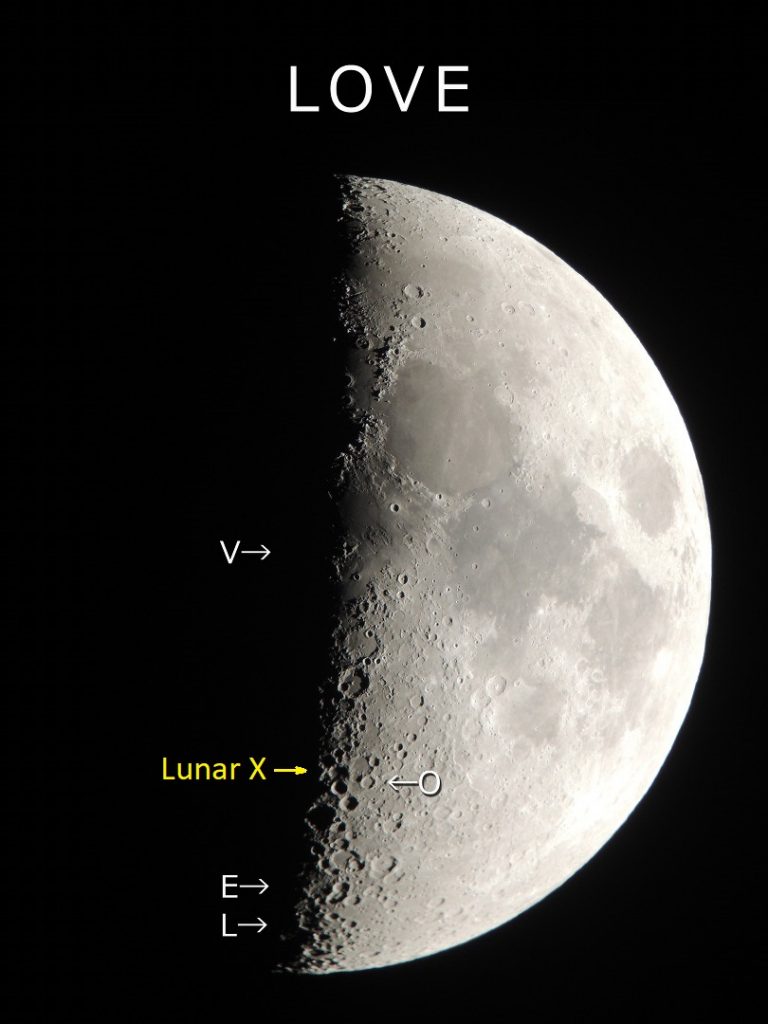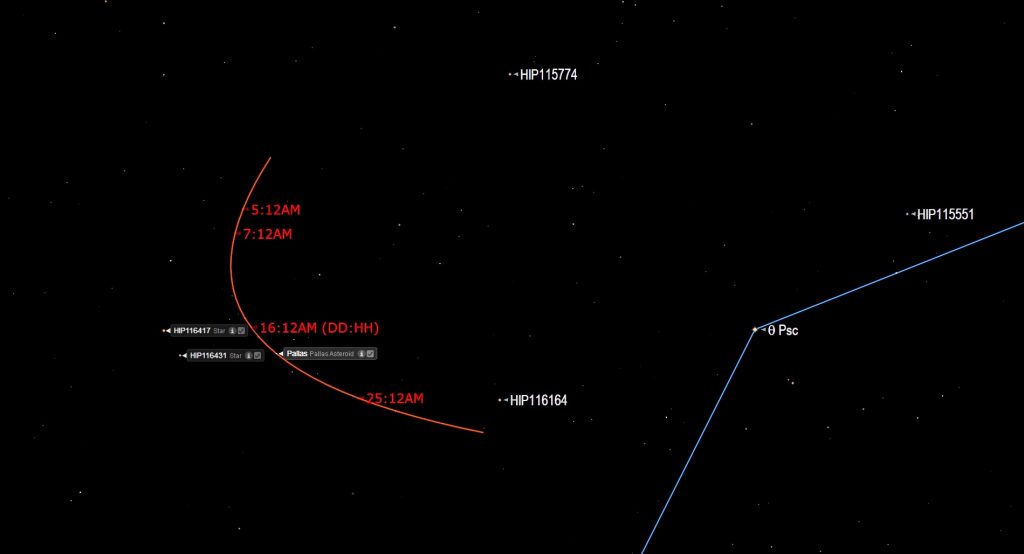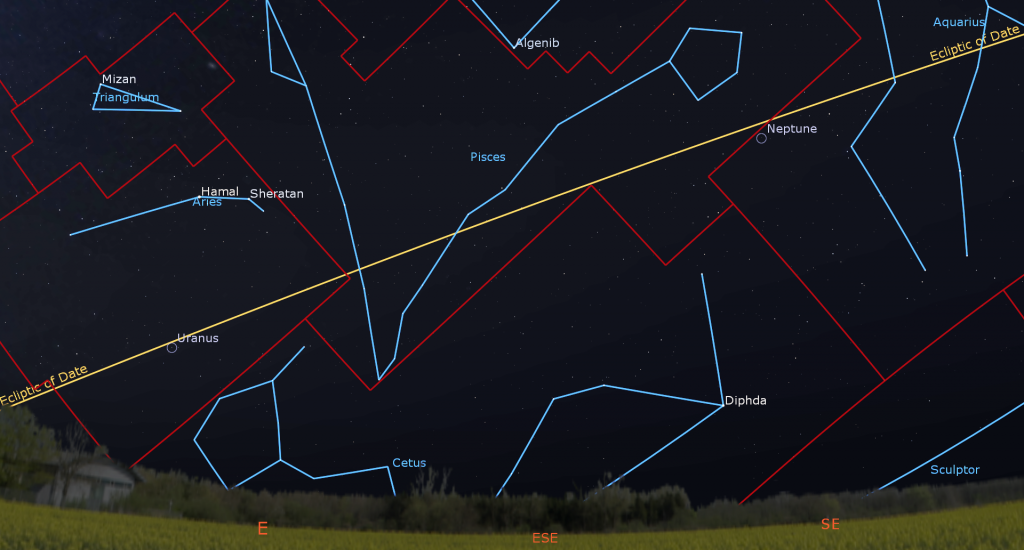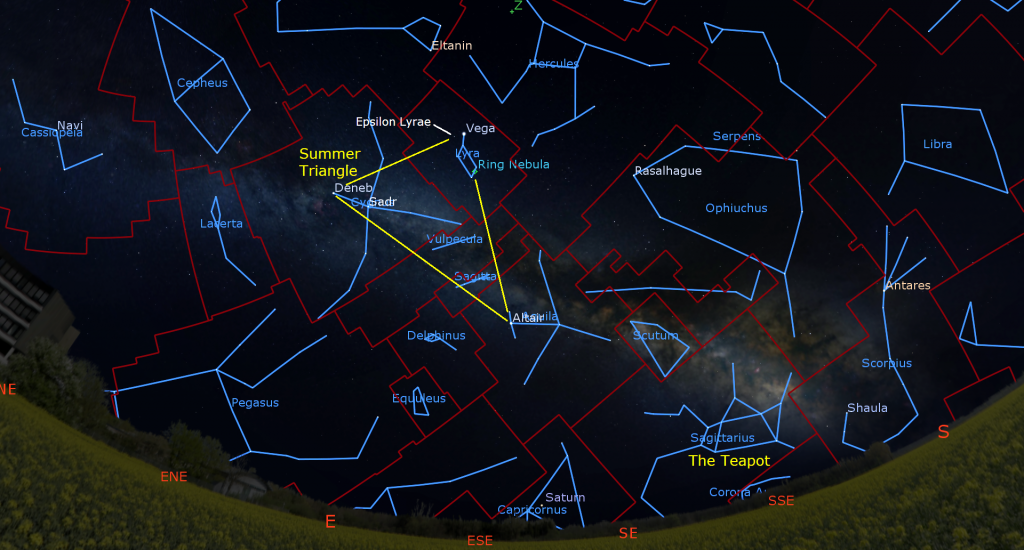Venus veers Past Mars near a Waxing Moon, Midnight Planets plus Pluto, Sights for Moon-nights, and Lunar X !

This simulated view of Saturn for this month shows how the rings are closed enough now to reveal a bit of Saturn’s southern polar region.
Hello, mid-July Stargazers!
Here are your Astronomy Skylights for the week of July 11th, 2021 by Chris Vaughan. Feel free to pass this along to your friends and send me your comments, questions, and suggested topics. You can also follow me on Twitter as @astrogeoguy! Unless otherwise noted, all times are expressed in Eastern Time. To subscribe to these emails please click this MailChimp link.
I can bring my Digital Starlab portable inflatable planetarium to your school or other daytime or evening event, or teach a session online. Contact me through AstroGeo.ca, and we’ll tour the Universe, or the Earth’s interior, together!
This week, the moon will return to the evening sky all around the world – just in time to join the close conjunction of dim Mars and brilliant Venus. Dim Pluto will be closest for 2021 in the midnight sky near Saturn and Jupiter, I share some sights to see with moonlight, and the moon sports an “X” on Friday night. Read on for your Skylights!
Lunar X in Early Evening
Several times a year, for a few hours near its first quarter phase, a feature on the moon called the Lunar X becomes visible in powerful, tripod-mounted binoculars and any size of backyard telescope. When the rims of the craters Purbach, la Caille, and Blanchinus are illuminated from a particular angle by the sun, they form a small, but very obvious X-shape.
The phenomenon is an example of pareidolia – the tendency of the human mind to see familiar objects when looking at random patterns. The Lunar X is located near the terminator, about one third of the way up from the southern pole of the moon (at lunar coordinates 2° East, 24° South). A prominent round crater named Werner sits to its lower right (or lunar southeast).
On Friday, July 16 the ‘X’ is predicted to start developing by about 7 pm EDT (or 23:00 Greenwich Mean Time). When the sun’s light first touches the crater rims the X will be indistinct. The shape will intensify and peak at around 9 pm EDT (or 01:00 GMT on July 17), and then gradually fade out over the next hour or two.
Unfortunately, this Lunar X will peak during waning daylight for observers in the eastern Americas, and in a bright sky for observers in the west – but you can still observe the moon in binoculars or a telescope during daytime, as long as you take care to avoid the sun. The Lunar X will be visible anywhere on Earth where the moon is shining, especially in a dark sky, between approximately 23:00 on July 16 and 03:00 GMT on July 17.

During a Lunar X event, you can also look for the Lunar V and the Lunar L. The “V” is produced by combining the small crater named Ukert with some ridges to the east and west of it. It is located a short distance above the moon’s equator at lunar coordinates 1.5° East, 8° North. For a further challenge, see if you can see the letter “L” down near the moon’s southern pole. Its position is to the southwest of three prominent and adjoining craters named Licetus, Cuvier, and Heraclitus which, in combination, resemble Mickey Mouse’s head and ears.
The Moon
The moon is back! After Friday’s new moon phase, our celestial sibling will shine as very thin crescent just above the west-northwestern horizon after sunset tonight (Sunday). Even better, the young moon will be positioned a generous palm’s width to the right (or 6.5 degrees to the celestial northwest) of the conjunction between very bright Venus and much fainter Mars. The trio will make a nice wide-field photo when composed with some interesting scenery – but catch them before they set at about 10 pm local time.
On Monday evening, the moon’s orbital motion will lift it above the two planets. As the moon waxes fuller and swings wider of the sun, it will traverse the stars of Leo (the Lion), and then it will cross the border into Virgo (the Maiden) on Wednesday night.
The entire week will offer fantastic views of the waxing moon in evening – both with your unaided eyes and with optical aids. The boundary line that divides the eastern lit hemisphere of the moon from its western dark hemisphere also passes through the moon’s poles. Formally known as the terminator, it also shows us where the sun is rising on the moon. Earth’s terminator speeds around our planet once in 24 hours. On the moon, that process takes nearly a month!
The zone beside the terminator is the best place to aim your telescope. The nearly-horizontal sunlight arriving there brightly illuminates every crater rim, mountain peak, ridge, and bump – and casts deep, black shadows toward lunar west. With no air to scatter light on the moon, the effect is breathtaking. And, new vistas are revealed each night as the terminator slides west. Watch the same crater over several nights, and see it gradually fill with light!
Virgo is a large constellation, measuring about 50 degrees from her outstretched arm to her toes! (On average, each zodiac constellation should span one-twelfth of a circle, or only 30 degrees.) The moon will spend Wednesday to Saturday among Virgo’s stars, passing only a palm’s width above her brightest star Spica on Friday night. (Lunar X night!)
The moon will officially complete the first quarter of its orbit around Earth, measured from new moon, at 6:10 am EDT (or 10:10 GMT) on Saturday, July 17. At first quarter, the moon’s 90 degree angle away from the sun will cause us to see a half-illuminated moon – on its eastern side. With first quarter occurring at dawn in the Americas, the moon will look close to half-illuminated both on Friday night and Saturday night. At first quarter, the moon always rises around mid-day and sets around midnight, so it is also visible in the afternoon daytime sky.
On Sunday night, the then gibbous (i.e., more than 50%-illuminated) moon will shine inside Libra (the Scales). The fact that the terminator was curved while the moon waxed and waned, and was a straight line at first and third quarter, told ancient astronomers that the moon was a sphere!
The Planets
The close conjunction between Venus and Mars this week will also complete our long window of seeing Mars in the evening sky, until it returns in August, 2022. In the meantime, here’s how to enjoy the Venus-Mars show!
As the sky darkens after sunset this week, find somewhere with an unobstructed view toward the west-northwest and look for the extremely bright dot of Venus shining less than a fist’s diameter above the horizon. Once the sky darkens more, the faint reddish dot of Mars, nearly 200 times fainter than Venus, will appear nearby. Binoculars will help in the search, but ensure that the sun has completely disappeared first!

Tonight (Sunday) Mars will be positioned only a finger’s width to Venus’ right (or 1° to the celestial southeast). That will put Venus between Mars and the slim crescent moon, which will be located well off to their right. Although both Venus and Mars are travelling eastward along the ecliptic, slower Mars is not able to offset the westward migration of the sky, while Venus can – so the two planets will pass one another on Monday-Tuesday. After that, Mars will sink sunward, leaving Venus to gleam as the “Evening Star” all year long.
On Monday, Mars will be positioned less than a pinky finger’s width to Venus’ lower left. (The moon will then be well above them.) On Tuesday, Venus will shine a pinky finger width directly above Mars. For the rest of the week, Venus will increase its distance to the upper left of Mars. The two planets will share the view in binoculars from about July 4 to 21, but they’ll only be telescope-close from July 11 to 14.Let me know if you see them, or if you get a photograph!
At the present time, Venus is situated on the far side of the sun from Earth. That, plus its angle of about 29° away from the sun will combine to make the planet look smaller than average and only 88% illuminated – producing a slightly squashed shape in your telescope. Aim your telescope at Venus as soon as you can find the planet’s brilliant white dot after sunset. At that time, it will be higher, and shining through less distorting atmosphere. It sets at about 10:30 pm local time.

On Saturday, July 17, the dim and distant dwarf planet designated (134340) Pluto will reach opposition for 2021. On that date, the Earth will be positioned between Pluto and the sun, minimizing our distance from that outer world. While at opposition, Pluto will be located 4.98 billion km or 277 light-minutes from Earth – and it will shine with an extremely faint visual magnitude of +14.3. That’s far too dim for visual observing through backyard telescopes. Pluto will be located in the sky about midway between Saturn and the bright star Nunki in Sagittarius’ Teapot asterism. Telescope-owners can focus on a magnitude 7.8 star named HIP97602, which will be sitting 9.3 arc-minutes (or one-third of the moon’s diameter) directly below Pluto on opposition night. Even if you can’t see Pluto directly, you will know that it is there!
This week, yellow-tinted, magnitude 0.3 Saturn will rise within the stars of central Capricornus (the Sea-Goat) shortly before 10 pm local time and then linger to shine in the southwestern sky until just before dawn. Saturn is being pursued across the sky by 16-times brighter Jupiter. If you stay up late, or wake up early, to see the gas giant planets, watch for the Milky Way and the teapot-shaped stars of Sagittarius (the Archer) sitting several fist diameters off to Saturn’s right (celestial west).
Even a small telescope will show Saturn’s rings and several of its brighter moons – especially its largest moon, Titan! Because Saturn’s axis of rotation is tipped about 27° from its orbital plane (a bit more than Earth’s tilt), we can see the top surface of its rings, and its moons can arrange themselves above, below, or to either side of the planet. During this week, Titan will migrate counter-clockwise around Saturn, moving from the upper right (west) of Saturn tonight (Sunday night) to the left (celestial north) of the planet next Sunday. (Remember that your telescope will probably flip the view around.) Saturn’s rings will be narrowing every year until the spring of 2025. This year, they are already narrow enough to reveal a bit of Saturn’s southern polar region.

This week the very bright, white, magnitude -2.7 planet Jupiter will rise just after 10:30 pm local time, and then follow Saturn across the southern sky until sunrise hides them. Jupiter is now moving slowly westward across the distant stars of central Aquarius (the Water-Bearer), a parallax effect produced when Earth, on a faster orbit, passes Jupiter on the “inside track” around the sun.
For Eastern Time Zone observers the Great Red Spot (or GRS) will be visible crossing Jupiter starting late Sunday night (July 11), Friday night, and late Sunday night (July 18), during the wee hours of Wednesday and Friday, and before dawn on Tuesday, Friday, and Sunday morning. From time to time, the small round black shadows cast by Jupiter’s four Galilean moons become visible in amateur telescopes when they cross (or transit) the planet’s disk. On Sunday morning, July 18 from 1 am to 3:45 am EDT (or 05:00 to 07:45 GMT), Europa’s small shadow will cross Jupiter.
On Sunday, July 18, the main belt asteroid designated (2) Pallas will halt its regular eastward motion in front of the distant stars, and begin a retrograde loop that will last until early November. Pallas’ visual magnitude of 9.7 will allow it to be seen in amateur telescopes starting in late evening. That night, Pallas will be positioned in the eastern sky, less than half a degree to the right (or celestial south) of the medium-bright star HIP116417 and the fainter star HIP116431, which sit near the ring of stars that forms the western fish in Pisces. The asteroid and those stars will appear together in the eyepiece of your telescope.

Dim, blue Neptune is following Jupiter across the sky. It rises at about 11:30 pm local time, and sits about 2 fist diameters to the left (or 21° to the celestial east) of Jupiter – near the border between Aquarius and Pisces (the Fishes). Magnitude 5.8 Uranus is bright enough to see in binoculars and backyard telescopes, even near cities. This week it will rise below the bright stars in Aries (the Ram) at about 1:30 am local time – but that time will be moving earlier by about half an hour per week.

Last up, literally, is Mercury, which will spend all of July in the eastern pre-dawn sky. Its position below (or to the celestial south of) the morning ecliptic will prevent Mercury from rising very long before the sun – making this appearance a poor one for Northern Hemisphere observers, but a good one for people viewing the planet from south of the equator. Mercury is now descending toward the sun – but the bright, magnitude -0.9 planet will be visible starting at about 5 am local time – when it will sit very low over the east-northeastern horizon.
Some Moonlight-Friendly Sights
While the moon will brighten evening skies all over the world this week, there are still plenty of sights to see.
Stars shine with a colouration that is produced by their surface temperatures, and this is captured in their spectral classification. The three bright stars of the Summer Triangle, namely Deneb, Vega, and Altair, are all A-class stars that appear blue-white to the eye and have surface temperatures in the range of 7,500 to 10,000 K. High in the southwestern sky, orange Arcturus is a K-class giant star with a temperature of only 4,300 K. Finally, reddish Antares, the heart of Scorpius (the Scorpion), is an old M-class star with a surface temperature of 3,500 K. By comparing these stars colors’ to other stars, you can estimate those stars’ temperatures. The classification letters, from hottest to coolest are: OBAFGKM. Can you think up a mnemonic phrase to remember the order? I have one.

The constellation of Lyra (the Harp) is positioned nearly overhead in late evening in early July. This constellation features a coffee and a donut! Keen eyes might reveal that the star Epsilon Lyrae, located just one finger’s width to the left (east) of the bright star Vega (Alpha Lyrae), is a double star. Binoculars or a small telescope will certainly show the pair. Examining Epsilon at high magnification will reveal that each of the stars is itself a double – hence its nick-name, “the Double-Double”. To see the donut, aim your telescope midway between the stars Sulafat and Sheliak, which form the southern end of Lyra’s parallelogram. Messier 57, also known as the Ring Nebula, will appear as a faint grey ring. Higher magnification works well on this planetary nebula – which is the corpse of a star that once had a similar mass to our sun.
Mid-July evenings bring us one of the best asterisms in the sky, the Teapot in Sagittarius (the Archer). This informal star pattern features a flat bottom formed by the stars Ascella on the east and Kaus Australis on the west, a triangular pointed spout pointing west, marked by the star Alnasl, and a pointed lid marked by the star Kaus Borealis. The stars Nunki and Tau Sagittarii form its handle. The asterism reaches maximum height above the southern horizon around midnight, when it will look as if it’s serving its hot beverage – with the steam rising as the Milky Way!
A Look at Ophiuchus
If you missed last week’s tour of the cool sights in Ophiuchus (the Serpent-Bearer), I posted it here.
Public Astro-Themed Events
Every Monday evening, York University’s Allan I. Carswell Observatory runs an online star party – broadcasting views from four telescopes/cameras, answering viewer questions, and taking requests! Details are here. Their in-person Wednesday night viewing has been converted to online via the observatory YouTube channel.
Don’t forget to take advantage of the astronomy-themed YouTube videos posted by RASC Toronto Centre and RASC Canada.
On Monday, July 12 at 10:30 pm EDT, RASC Victoria Centre will live-stream a free public event called Astronomy Cafe – Lunar Evening with two moon experts. More information is here.
On Tuesday, July 14 at 7 pm EDT, RASC National will continue their weekly online sessions Games in Space – Out of Space featuring Jenna Hinds and guests. Details are here and the registration link is here! Sessions are also livestreamed to YouTube here and can be watched at any time.
Our public sessions at the David Dunlap Observatory may not be running at the moment, but we are pleased to offer some virtual experiences instead in partnership with Richmond Hill. On Friday, July 16 from 9:30 to 11 pm EDT, join RASC Toronto Centre astronomers for Up in the Sky. Weather permitting they’ll stream live views through telescopes – and maybe even the DDO’s giant 74” telescope! Deadline to register for this program is Friday, July 16, 2021 at 3 pm. Prior to the start of the program Richmond Hill will email you information on the virtual program links and any specific information relating to your program. The registration link is here.
My free, family-friendly Insider’s Guide to the Galaxy webcasts with Jenna Hinds of RASC National will return on July 20 with a Summer Stargazing Spectacular! You can find more details, and the schedule of future sessions, here and here.
Keep looking up, and enjoy the sky when you do. I love questions and requests. Send me some!